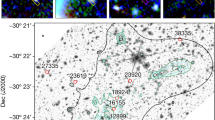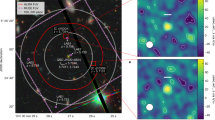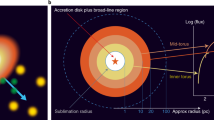Abstract
The origin of the X-ray emission for the central region of our Galaxy has remained a mystery1,2,3,4. In particular, the relative spectral contributions of the diffuse emission and discrete sources, which are critical to understanding the high-energy phenomena in this environment, have been unclear because of the lack of sufficient spatial resolution. Here we report the results of a large-scale imaging survey of the Galactic Centre that resolves these components. We find that the Kα emission from iron that has been highly ionized (so that it has only two electrons left), which has previously been attributed to the diffuse component1, actually arises mainly from discrete sources. This suggests that the presence of a large amount of hot gas (T ≈ 108 K) is no longer required to explain the iron line emission. The spectra of the discrete sources indicate the presence of numerous accreting white dwarfs, neutron stars, and/or black holes in the region. The diffuse emission dominates over the contribution from the faint point sources, and is shown to be associated globally with interstellar features that have been observed at radio and mid-infrared wavelengths, suggesting that it is the product of recent massive star formation.
This is a preview of subscription content, access via your institution
Access options
Subscribe to this journal
Receive 51 print issues and online access
$199.00 per year
only $3.90 per issue
Buy this article
- Purchase on Springer Link
- Instant access to full article PDF
Prices may be subject to local taxes which are calculated during checkout



Similar content being viewed by others
References
Koyama, K. et al. ASCA view of our Galactic center: Remains of past activities in X-rays? Publ. Astron. Soc. J. 48, 249–255 (1996).
Sidoli, L. & Mereghetti, S. The X-ray diffuse emission from the Galactic center. Astron. Astrophys. 349, L49–L52 (1999).
Valinia, A. et al. On the origin of the iron K line in the spectrum of the Galactic X-ray background. Astrophys. J. 543, 733–739 (2000).
Tanaka, Y., Koyama, K., Maeda, Y. & Sonobe, T. Unusual properties of X-ray emission near the Galactic center. Publ. Astron. Soc. J. 52, L25–L30 (2000).
Wang, Q. D., Gotthelf, E. V., Lang, C. & Jagodzinski, F. UMass/Columbia Chandra X-ray survey of the Galactic center region. Astrophys. J. (submitted).
Sidoli, L., Belloni, T. & Mereghetti, S. A catalogue of soft X-ray sources in the Galactic center region. Astron. Astrophys. 368, 835–844 (2001).
Sakano, M. et al. ASCA X-ray source catalogue in the Galactic center region. Astrophys. J. Suppl. Ser (in the press); also as preprint astro-ph/0108376 at 〈http://xxx.lanl.gov〉 (2001).
Ebisawa, K. et al. Origin of the hard X-ray emission from the Galactic plane. Science 293, 1633–1635 (2001).
Barret, D. et al. Hard X-ray emission from low-mass X-ray binaries. Astrophys. J. 533, 329–351 (2000).
Feng, Y. X. et al. Evolution of iron Kα: Line emission in the black hole candidate GX339-4. Astrophys. J. 553, 394–398 (2001).
Yusef-Zadeh, F. et al. Detection of X-ray emission from the Arches cluster near the Galactic center. Astrophys. J. (in the press); also as preprint astro-ph/0108174 at 〈http://xxx.lanl.gov〉 (2001).
Baganoff, F. et al. Rapid X-ray flaring from the direction of the supermassive black hole at the Galactic Centre. Nature 413, 45–48 (2001).
Murakami, H., Koyama, K. & Maeda, Y. Chandra observations of diffuse X-rays from the Sagittarius B2 cloud. Astrophys. J. 558, 687–692 (2001).
Maeda, Y. et al. A Chandra study of Sgr A East: A supernova remnant regulating the activity of our Galactic center? Astrophys. J. (in the press).
Jackson, J. M., Heyer, M. H., Paglione, T. & Bolatto, A. HCN and CP in the central 630 parsecs of the Galaxy. Astrophys. J. 456, L91–L95 (1996).
Price, S. D. et al. Midcourse space experiment of the Galactic plane. Astrophys. J. 121, 2819–2842 (2001).
Fromerth, M. J., Melia, F. & Leahy, D. A. A Monte Carlo study of the 6.4 keV emission at the Galactic center. Astrophys. J. 547, 129–132 (2001).
Tsuboi, M., Ukita, N. & Handa, T. An expanding shell-like molecular cloud near the Galactic center arc. Astrophys. J. 481, 263–266 (1997).
Yusef-Zadeh, F., Wardle, M. & Parastaran, P. The nature of the Faraday screen toward the Galactic center nonthermal filament G359.54+0.18. Astrophys. J. 475, 119–122 (1997).
Boggs, S. E. et al. Diffuse galactic soft gamma ray emission. Astrophys. J. 544, 320–329 (2000).
Figer, D. et al. Hubble Space Telescope/NICMOS observations of massive stellar clusters near the Galactic center. Astrophys. J. 525, 750–758 (1999).
Wang, Q. D. Structure and evolution of hot gas in 30 Dor. Astrophys. J. 510, L139–L143 (1999).
Almy, R. C., McCammon, D., Digel, S. W., Bronfman, L. & May, J. Distance limits on the bright X-ray emission toward the Galactic center: Evidence for a very hot interstellar medium in the Galactic X-ray bulge. Astrophys. J. 545, 290–300 (2000).
Sofue, Y. Bipolar hypershell Galactic center starburst model: further evidence from ROSAT data and new radio and X-ray simulations. Astrophys. J. 540, 224–235 (2000).
Townsley, L. K., Broos, P. S., Garmire, G. & Nousek, J. Mitigating charge transfer inefficiency in the Chandra X-ray observatory advanced CCD imaging spectrometer. Astrophys. J. 534, L139–L142 (2000).
Yusef-Zadeh, F., Morris, M. & Chance, D. Large, highly organised radio structures near the galactic centre. Nature 310, 557–561 (1984).
Acknowledgements
We thank F. Jagodzinski for assistance in the data calibration, and L. Townsley for helping with the CTI corrections.
Author information
Authors and Affiliations
Corresponding author
Ethics declarations
Competing interests
The authors declare no competing financial interests.
Rights and permissions
About this article
Cite this article
Wang, Q., Gotthelf, E. & Lang, C. A faint discrete source origin for the highly ionized iron emission from the Galactic Centre region. Nature 415, 148–150 (2002). https://doi.org/10.1038/415148a
Received:
Accepted:
Issue Date:
DOI: https://doi.org/10.1038/415148a
This article is cited by
-
Compact sources as the origin of the soft γ-ray emission of the Milky Way
Nature (2004)
-
X-rays reveal the Galaxy's centre
Nature (2002)
-
Hubbub at galactic hub
Nature (2002)
Comments
By submitting a comment you agree to abide by our Terms and Community Guidelines. If you find something abusive or that does not comply with our terms or guidelines please flag it as inappropriate.



